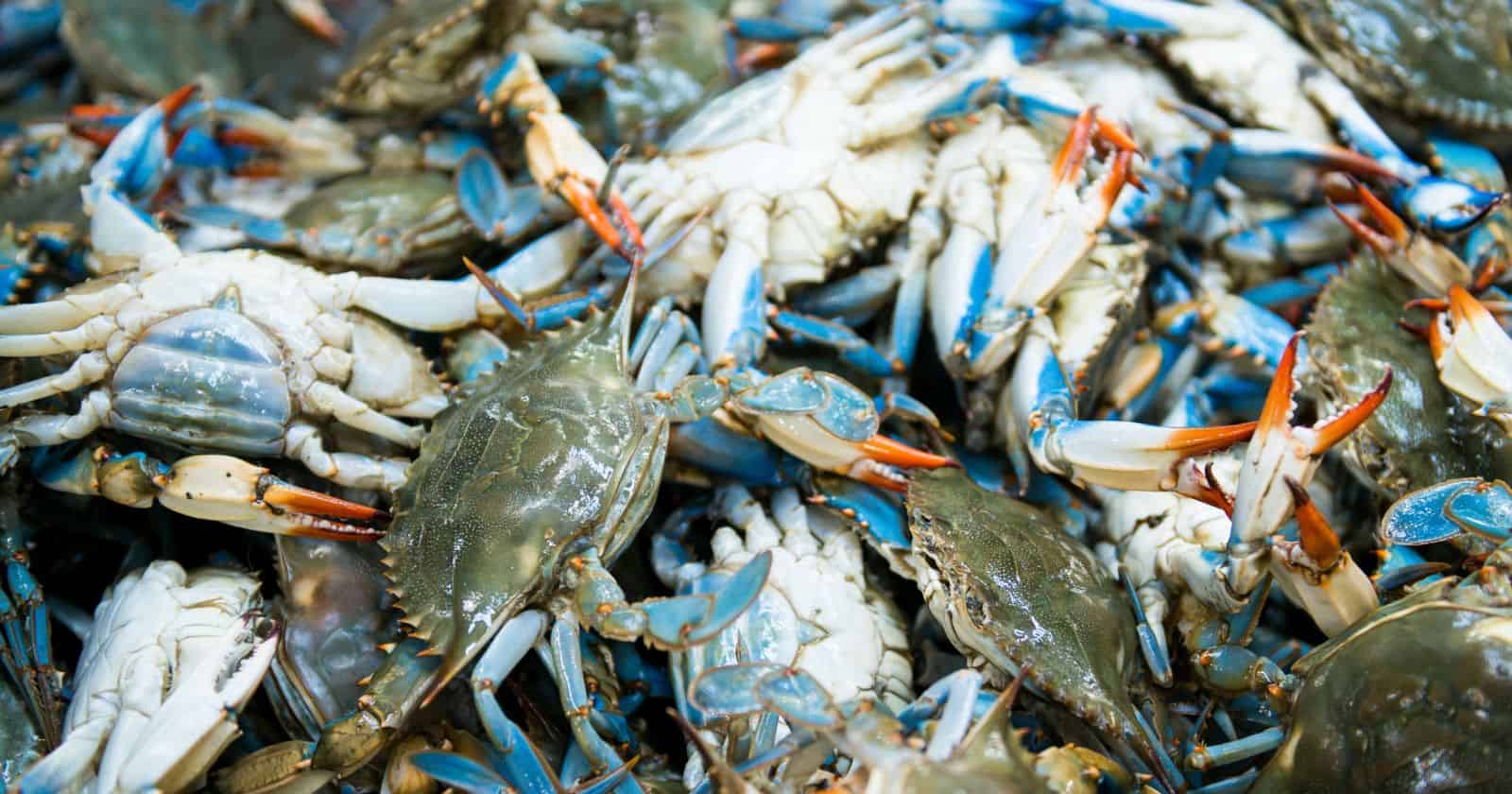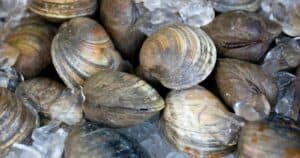Yes, it’s true; blue crabs turn a vibrant shade of red once they’re cooked.
But why does this happen?
The answer lies in the unique carotenoid pigment, astaxanthin, found in these creatures’ shells.
When exposed to heat, the proteins in the body break down and tell the red dye, giving your crab that familiar color.
Moving on, we’ll be exploring other interesting facts about blue crabs, their habitat, dietary habits, and why they make such a popular seafood choice for people worldwide.
We’ll also give you the inside scoop on how to cook blue crabs and how to prepare them.
The Color Transformation: Why Blue Crabs Turn Red When Cooked
Blue crabs turn red when cooked due to a pigment called astaxanthin in their shells.
This pigment absorbs blue light and appears red under certain conditions.
When blue crabs are cooked, the chemicals inside their bodies react with the heat, causing color transformation.
Heating a protein complex called crustacean untwists it and fully exposes the red color of astaxanthin.
Overall, this is the reason why blue crabs and other marine creatures turn red when cooked.
Crustacyain is a protein complex found in the exoskeletons of crustaceans, including blue crabs.
When heated, it undergoes a structural change that exposes astaxanthin as a bright red pigment.
Interestingly, the amount of astaxanthin in a blue crab’s shell depends on various factors, including diet and water temperature.
When crabs eat a diet rich in astaxanthin, their shells will have brighter red color when cooked, making them more visually appealing on a plate.
Apart from its color-changing properties when cooked, astaxanthin is known for its many health benefits.
This potent antioxidant is found in various seafood and has been shown to help reduce inflammation, improve heart health, and even enhance exercise performance.
All About Astaxanthin: Understanding the Pigment in Blue Crab Shells
Astaxanthin can absorb blue light, making the body appear red when cooked.
But there’s more to Astaxanthin than just changing the color of the crab shell.
Astaxanthin belongs to the carotenoid family of pigments and is found in various seafood, such as salmon, trout, and shrimp, other than blue crabs.
The exciting thing about Astaxanthin is its potent antioxidant properties that can offer several health benefits to humans.
Studies have shown that Astaxanthin can improve skin health, reduce inflammation, boost heart health, and even enhance exercise performance.
The 3D-nanoarchitecture of blue crab shells is color-specific, containing pigments that reflect blue and red-orange hues.
Astaxanthin is present in blue crab shells but is hidden under a protein covering that camouflages its red color.
When the body is cooked, the protein complex untwists and exposes the Astaxanthin pigment, leading to the red coloration we observe.
This is why blue crab shells turn from a bluish color to a bright red color when cooked.
Blue Crab Habitat: Where Can You Find These Crustaceans?
Blue crabs can be found in various habitats, from shallow, brackish waters with underwater grasses and oyster reefs to deeper, saltier waters.
These crustaceans usually inhabit estuaries and brackish coastal lagoons.
Along the Atlantic Coast and in the Gulf of Mexico in the United States, blue crabs are also found in coastal waters, and their range extends as far south as Uruguay.
Blue crabs are scavengers and hunters, feeding on clams, oysters, insects, mussels, worms, and fish that have died recently.
They are also known to eat other crustaceans.
These creatures often bury themselves in the sand or mud during the day and come out at night to search for food.
Blue crabs can live in water with varying salinity levels, from fresh to full seawater.
However, females prefer to lay their eggs in water with lower levels of salt content.
Blue crabs also prefer to live in areas with plenty of hiding places, such as rocks or seaweed, where they can escape predators.
Blue crabs are adaptable creatures found in diverse habitats, from shallow waters with underwater grasses and oyster reefs to more deep, saltier coastal waters.
They prefer waters with hiding places and varying salinity levels, and females like to lay their eggs in water with lower salt content.
These crustaceans are scavengers and hunters, eating a variety of food sources, and are known to bury themselves during the day, coming out at night to hunt for food.
Blue Crab Diet: What Do They Eat and How Do They Hunt?
Blue crabs are scavengers and hunters that eat almost anything they can find.
They feed on clams, oysters, mussels, smaller crustaceans, freshly dead fish, plant and animal detritus, and even smaller, soft-shelled blue crabs.
They are opportunistic eaters and can consume various food resources such as mollusks, fish, crustaceans, and vegetal matter.
Blue crabs are skilled hunters and use their claws to capture prey.
They have strong feet that allow them to crush the shells of their game.
They also employ a variety of hunting techniques that make them successful predators.
For example, they use their sense of touch to locate prey in the sand or mud and then ambush it.
They can also use their claws to overturn rocks or dig in the sand to find food.
Blue crabs are far from the top of the food chain despite their hunting prowess.
Large fish and some fish-eating birds like great blue herons and sea turtles eat them.
They are also a popular food source for humans and are harvested commercially.
However, it’s important to note that overfishing and habitat destruction has led to declines in blue crab populations in some areas.
Why Blue Crabs Are So Popular: A Look at the Economic and Culinary Value
Blue crabs are famous because they are economically and culinarily valuable.
They support a valuable commercial and recreational fishery in the Chesapeake Bay and Gulf of Mexico, with blue crab landings in Maryland alone estimated at $45 million.
Louisiana supports around 26 million pounds of blue crab annually.
But it’s not just about the money – blue crabs are known for their sweet and delicate flavor.
They are popular in crab cakes, soup, and steamed crabs that many people enjoy.
Blue crabs are also sustainable, as their populations can be managed through regulations and conservation efforts.
For example, the Chesapeake Bay Blue Crab Fisheries Management Plan has helped to rebuild the blue crab population in the bay since it was first implemented in 2008.
However, there are concerns about the sustainability of the blue crab fishery.
Habitat loss, pollution, and climate change are all factors that can affect blue crab populations, so it is essential to continue conservation efforts to ensure that future generations can enjoy this valuable seafood.
Cooking Blue Crabs: The Different Methods and Techniques
Blue crabs can be cooked in a variety of ways.
One popular method is to boil them in a big pot filled with seasoned water.
Another way is to steam them in a basket over boiling water.
You can also drop them into boiling water and cook them for 10 minutes.
When cooked properly, blue crabs will turn bright red and be ready to eat.
In boiling blue crabs, it’s essential to use a big, sturdy pot and enough water to submerge them completely.
Season the water with salt and your favorite spices, like Old Bay seasoning.
Let the water come to a rolling boil before adding the crabs.
Cook the crabs for 15 minutes, depending on their size, until they turn red.
Remove from heat and let them cool slightly before cracking them open.
Steaming blue crabs is another popular method.
Fill a steamer basket with enough crabs to make one layer, then sprinkle with salt and seasoning.
Boil water in a pot and place the steamer basket on top.
Cover the pot and steam the crabs for about 20-30 minutes until they turn bright red.
Serve them up with butter and lemon for a delicious treat.
You can drop the crabs directly into boiling water if you prefer a quicker method.
This method only takes about 10 minutes, but ensuring the crabs are entirely submerged is essential.
Season the water with salt and your favorite spices to add some flavor.
Once the crabs turn red, they’re ready to be enjoyed.
Preparing Blue Crabs: Cleaning, Seasoning, and De-Shelling Techniques
To clean blue crabs, you can either pop off the back shell and use a hose to spray the insides or rinse under cold running water.
To de-shell blue crabs, you must master “picking” or removing the meat from its shell by following videos or steps.
And to season blue crabs, use Old Bay Seasoning or other spices such as garlic powder, paprika, cayenne pepper, and lemon juice.
When it comes to cleaning blue crabs, popping off the back shell is a method used by many.
To do this, you need to hold the crab with one hand and pull the back shell upwards with the other.
Once you’ve removed the body, you can spray the insides with a hose.
Another method is to rinse the crabs under cold running water to remove dirt or debris.
For soft-shell crabs, rinse them under cold water to remove any dirt or debris clinging to them crabs.
De-shelling blue crabs requires some technique.
Start by removing the claws and legs from the crab.
Next, hold the body with one hand and use the other hand to push out the meat from inside the body.
Break the body in half and remove the meat from the inside.
For the claws and legs, use a nutcracker to crack the shell and remove the core.
Seasoning blue crabs can be as simple as using Old Bay Seasoning.
Just mix your desired herbs and sprinkle over the crab before steaming.
To do this, sprinkle some seasoning over the crab and steam for about 10 minutes.
You can also use other spices, such as garlic powder, paprika, cayenne pepper, and lemon juice, to season blue crabs.



